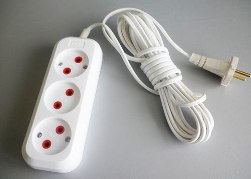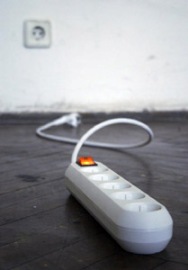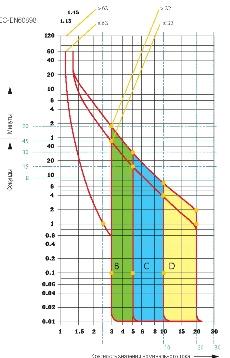Categories: Electrician at home, Electrical connection of equipment
Number of views: 194,416
Comments on the article: 28
Why it is dangerous to use tees and extension cords in an apartment
 Nowadays, the number and variety of household appliances in apartments is increasing every day, but the number of outlets remains the same.
Nowadays, the number and variety of household appliances in apartments is increasing every day, but the number of outlets remains the same.
Most people living in old apartments with two or three sockets per room have to somehow get out and use tees and extension cords to connect various electrical appliances. The main thing here is not to overdo it, as the ill-considered use of extension cords is very dangerous for you and your apartment.
In this article, let's understand Why is it so dangerous to use tees and extension cords?
Firstly, it is not safe. in terms of possible electric shock. The greatest danger is the use of extension cords in bathrooms. The extension cord is subject to constant physical stress, twisting. Particularly dangerous in this regard are improvised extension cords and carrying.
Then, it's just not beautiful. Extension cords spoil the view of the room, not comfortable, constantly get confused and wallowing under your feet.
The most important thing - the use of tees and extension cords may cause a fire in the apartment. The reasons for this need to be discussed in more detail.
If you have a power outlet in the right place, you want it — you don’t want it, but the ability to include something too powerful in it and even in large quantities is very limited. If we have a tee, or an extension cord with more than two outlets, then in this case there are many temptations to load them as much as possible.
 I have met cases when the extension cord included a refrigerator, a microwave, a TV, and sometimes food processor and yet iron with a vacuum cleaner. As a result, we have a heavily overloaded wiring with seriously spoiled high temperature and fire hazardous insulation.
I have met cases when the extension cord included a refrigerator, a microwave, a TV, and sometimes food processor and yet iron with a vacuum cleaner. As a result, we have a heavily overloaded wiring with seriously spoiled high temperature and fire hazardous insulation.
You say that with current overload it should work circuit breaker. Yes it should. But after all, it does not always really work. What could be the reasons for this?
The worst case is the wrong machine. You know how often it happens: “Something the machine began to turn off constantly” and a good friend electrician replaces the 10A machine with 16A, and there are also options with 25A. This is so that the machine would not turn off, at least in the next few decades.
It is impossible to replace circuit breakers with devices with high rated current with impunity without replacing the wiring! Circuit Breaker Selection - This is the most important thing when installing household wiring and if you entrust this process to a neighbor, because If he works as an electrician in a factory, or trying to choose a circuit breaker on his own without a serious understanding of how to do this correctly, this will definitely lead to a fire.
The second reason for the failure of the machine with an obvious overload may be the quality of the machine itself. Even among the products of the right brands (Siemens, Legrand, Schneider Electric), defective copies sometimes come across. According to people constantly engaged in picking electrical panels - about 5% of all products. Among other manufacturers, the percentage of circuit breakers with response times not corresponding to the passport data is much higher.
Before installation, all protection devices must be tested. Industrial enterprises usually do this. To do this, use special devices, for example, type UPTR-MC. In everyday life, it is very rare that machines are checked before installation. There are responsible electricians who have devices for testing circuit breakers (often home-made), but such units.
The third option - the machine could be operational at the time of installation in the switchboard, but as a result of regular trips, it was severely damaged and the reliability of its operation in the event of current overload became unpredictable.
The fourth option is the most dangerous and rarely taken into account by anyone. Even the presence of a correctly selected high-quality and serviceable circuit breaker does not guarantee that your cable overloaded with the extension cord will not burn before the circuit breaker is turned off.
The reason for this is the time it turned off during overload. Instantly, the circuit breaker trips only at high currents (usually during short circuits), i.e., instantaneous tripping occurs only with a sharp increase in current, and then only when the current exceeds the operating current of the electromagnetic release.
For the most common circuit breakers with type C time-current characteristic To turn off the machine, the current flowing through it must reach 5-10 times the value of the rated current of the machine. For example, a 16A circuit breaker - this current is - 80 - 160 A.
Time-current (protective) characteristic of the circuit breaker (to enlarge, click on the picture)
The thermal release of the circuit breaker must respond to current overloads, which, due to its inertia, cannot operate instantly. And if you carefully look at the protective characteristic of the machine, then even with current overload on 30%, i.e. when current flows through the machine about 21 And, the machine will disconnect the circuit only for 20 - 40 min With a double overload - in 3 minutes. A double overload is already 32 A!
With prolonged exposure to temperatures above 70-75 aboutWith the intense oxidation of contact compounds and a sharp increase in their transition resistance, which causes strong local heating and a further dangerous increase in temperature.
Overheating of the cable insulation leads first to a deterioration of the insulating properties and a decrease in the service life, and then to the destruction of the insulation. Part of the heat released by the cable is used to heat the cable itself and increase its temperature. What this part is depends on how the cable is laid.
There are also options for periodically overloading the cable with its obvious overheating, but the machine will not work precisely because of the relatively short duration of the periods when additional power consumers are included in the extension cord. Moreover, each even short-term cable overload brings its insulation closer to destruction.
Conclusion: use extension cords and tees in the apartment only in the most necessary cases. If possible, try to do without them. When repairing, upgrade the wiring and increase the number of outlets in the apartment, placing them in the places of installation of electrical appliances. Remember, the uncontrolled use of tees and extension cords in houses with old wiring is a direct road to fire!
See also at e.imadeself.com
:

